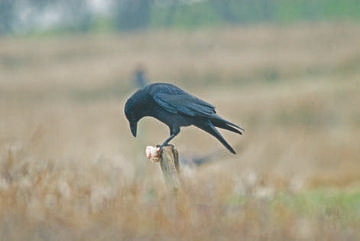
Carrion Crow © Peter Smith
With such a territorial bird, breeding adults maintaining their territories all year round, there would not be expected to be much seasonal change in Carrion Crows’ distribution. Probably the most notable difference, clearly visible on the map showing difference between breeding and winter, is their occupation of coastal and saltmarsh tetrads on the north Wirral and in both estuaries. The birds visiting these squares are members of the non-breeding flocks, exploiting a wide range of food resources including fish, marine molluscs, saltmarsh seeds and almost anything edible amongst the shoreline detritus.
Their main change in habitat for winter is a shift from woodland (14% of winter records) or scrub (2%) to farmland (67%), mostly improved grassland but including unimproved grassland (7%) and stubble (5%), where there were more records of Carrion Crows than any other corvid. They also seemed to use recently ploughed fields more than other species, along with manured fields and sheep pasture. Many of the records comprising ‘human sites’ (13% of the total) came from birds foraging at sewage works or landfill sites and scavenging on refuse in retail areas. Such adaptability in their diet underlies the species’ success.
Despite the advice to novice birdwatchers that ‘if you see one or two, they’re Crows; if you see a flock, they’re Rooks’, the non-territorial Carrion Crows frequently form quite large flocks. Out of 699 counts submitted with Atlas records, only 144 were of one or two birds, with half of them being of ten birds or more, including 30 flocks of 100 or more. By far the largest were the gatherings of 500 birds seen by Steve Holmes and Marion Barlow near Thornton-le-Moors (SJ47M) in 2006/ 07, and 420 on a ploughed field on 3 December 2005 near Kidnal (SJ44U) counted by Neil Friswell.
Carrion Crows also congregate to roost overnight together, usually in traditional sites in dense woodland; six such gatherings of 100 or more birds were reported during this survey, with up to 300 birds near Higher Whitley (SJ68A). Carrion Crows are usually the last birds to go to roost at night, often well after dusk, and the earliest to leave in the mornings at the first glimmer of daylight. Some local territory-holders join the roosting flocks, and presumably they are especially keen to return to defend their areas against potential intruders (BTO Winter Atlas).
Sponsored by Tom Rowbottom

